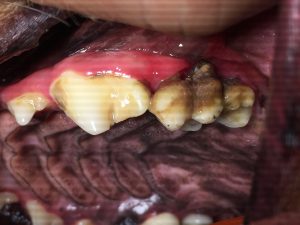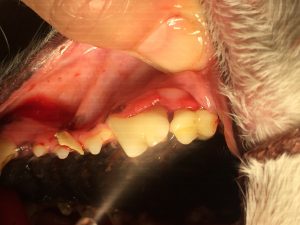Dental Health in Dogs and Cats
Dental disease is one of the most common and painful conditions that affect dogs and cats but it is also the most treatable. Signs of dental disease in pets include foul breath but also missing or loose teeth, swollen bleeding gums and also problems that can occur under the gums that may not be so visible.
“Dog breath” – or a cat with a foul-smelling mouth – can be a sign of untreated dental conditions. If left untreated, you may put your pet at risk for greater problems such as periodontitis or heart disease.
Here are some photos of various stages of dental disease in dogs and cats that we see here at the Granville Veterinary Clinic.
For pets that don’t yet have obvious signs of dental and gum disease, routine cleanings can help prevent periodontal disease and save money in the long run. A 2014 analysis conducted by Veterinary Pet Insurance Co. showed that the average cost per pet to prevent dental disease is just one-third of the average cost of treating dental disease.
More importantly, a complete oral examination can detect hidden health problems. Even if your pet’s breath smells fine, there still could be dental conditions that are hard to spot without a complete veterinary exam. Schedule your pet’s dental checkup with us. We will do a thorough checkup to make sure your pet is in optimum health. We also can show you how to brush your pet’s teeth in between exams. We also have some additional dental products that can work very well to prevent continued tartar and plaque buildup.
Learn more about what you can expect from your pets dental procedure.
Pet Dental Care Facts
Good dental hygiene can ADD 3 to 5 years to your pet’s life.
Dental disease can lead to more serious problems such as heart, lung and kidney disease.
Approximately 70 to 80% of cats and dogs will show signs of dental disease by age 3 (without proper prevention).
Bad breath isn’t normal in your cat or dog — it’s most likely a sign of oral problems.Plaque and tarter will form naturally in the cracks of teeth, especially near the gum line, every time your pet eats. If left to spread, plaque can lead to gingivitis, an inflammation of the gums, causing them to become red, swollen, and painful. Plaque will soon harden into tarter that separates the tooth from the gum if left untreated. Eventually, infection may build up near the root of the tooth, causing it loosen. At this stage, bleeding and pain will occur whenever your pet tries to eat.
Brushing Your Pet’s Teeth
Relax — It’s easier than you think. Here are some tips on how to brush your pet’s teeth:
Get your pet used to the idea by dipping your finger into something yummy (tuna water, chicken broth) and gently rub along their teeth and gum line for a few seconds. Do this for a few days, leaving your finger in their mouth a little longer each time.
Introduce gauze wrapped over your finger, and continue dipping it into something tasty for another few days.
Gradually, start using pet toothpaste on the gauze and rub the teeth and gums in a circular motion.
After your pet feels comfortable with this routine, you may introduce a soft-bristled toothbrush or a specially-designed pet toothbrush.
Remember to praise, praise, praise during each training session and remember that every animal is different — some will enjoy this “bonding session”, while others will see it as a complete invasion of their personal space!
We also have some very good dental treats that block plaque, calculus and bad breath that have been working really well for us. Call us for more information.


